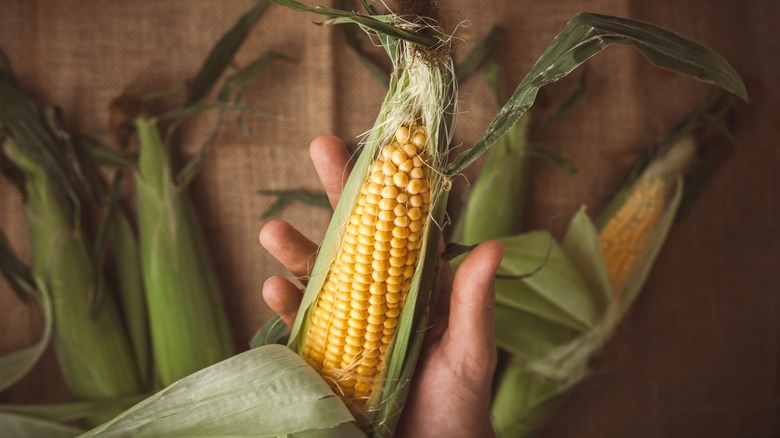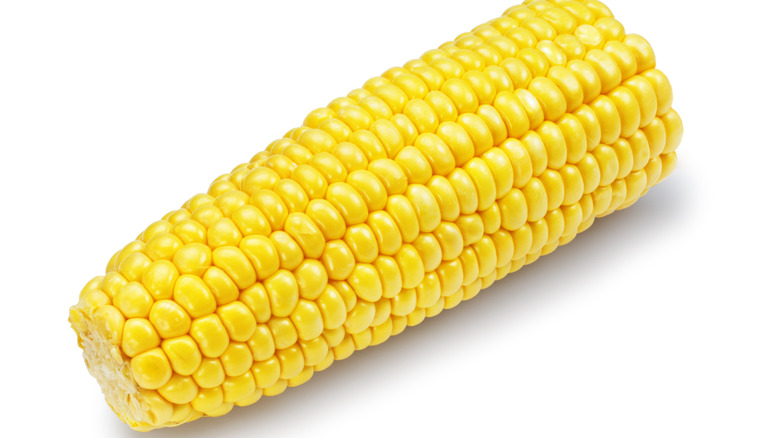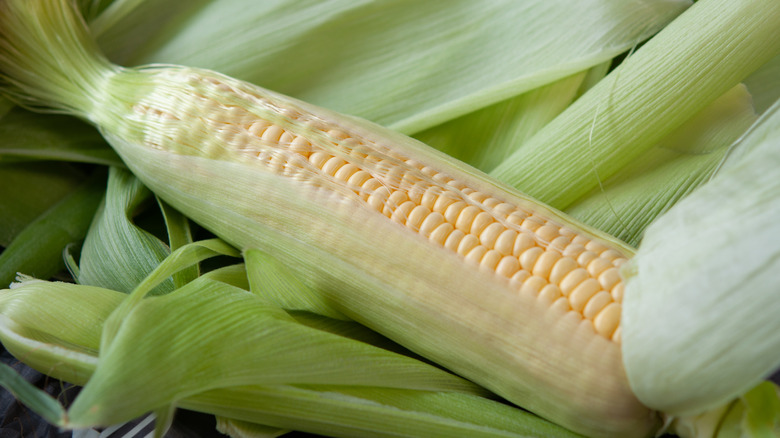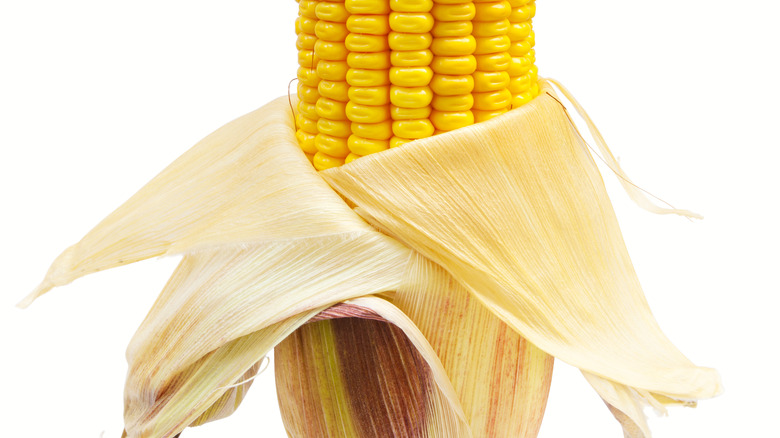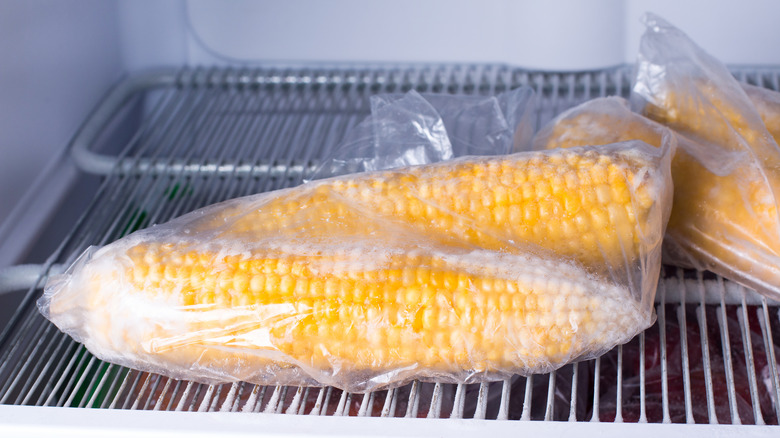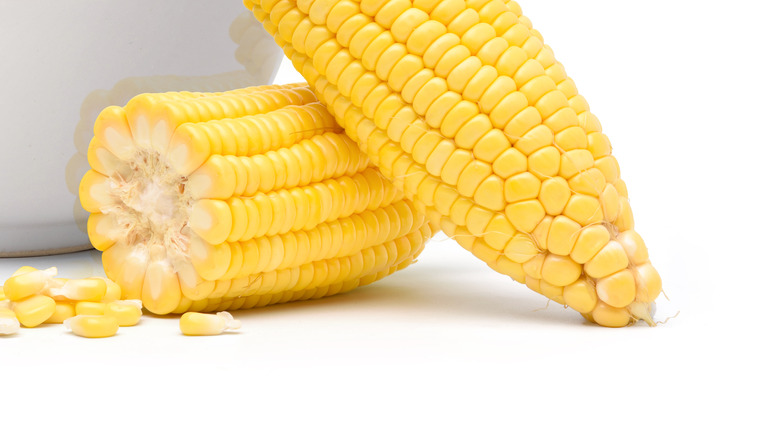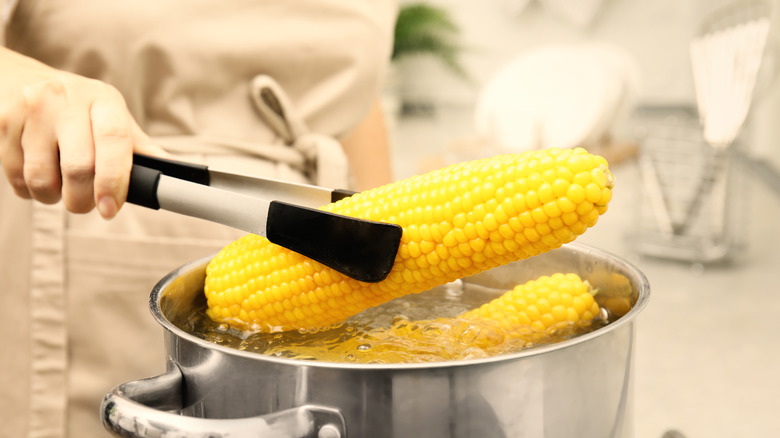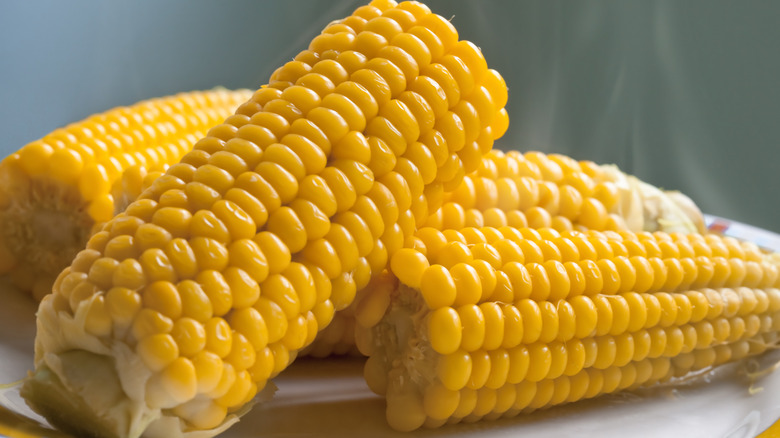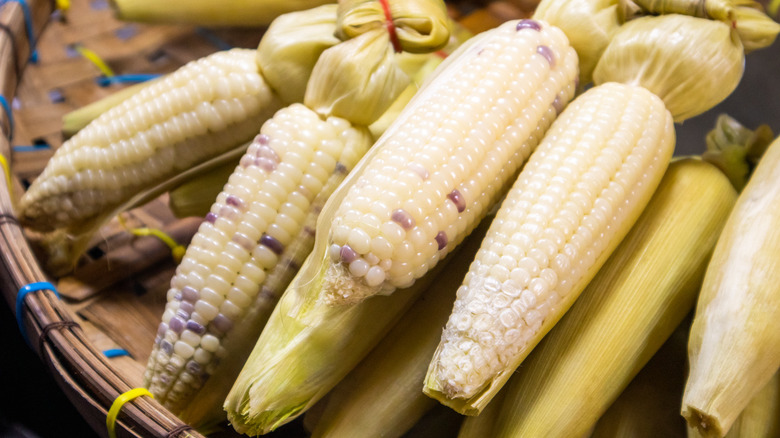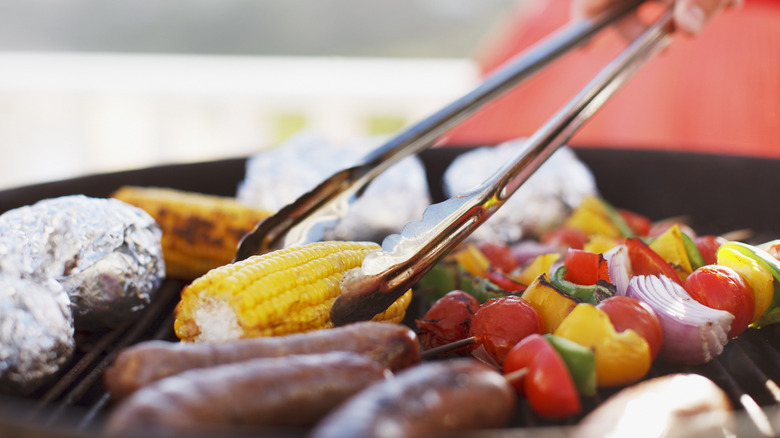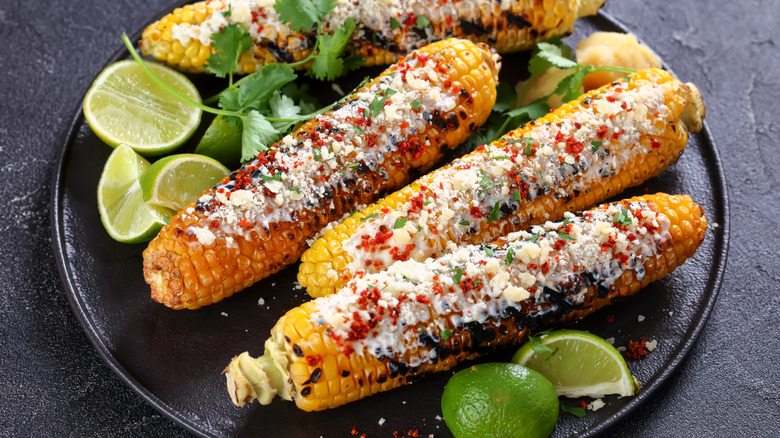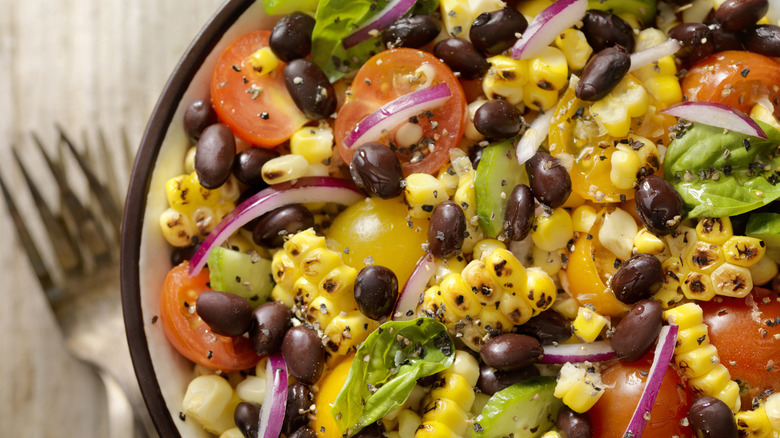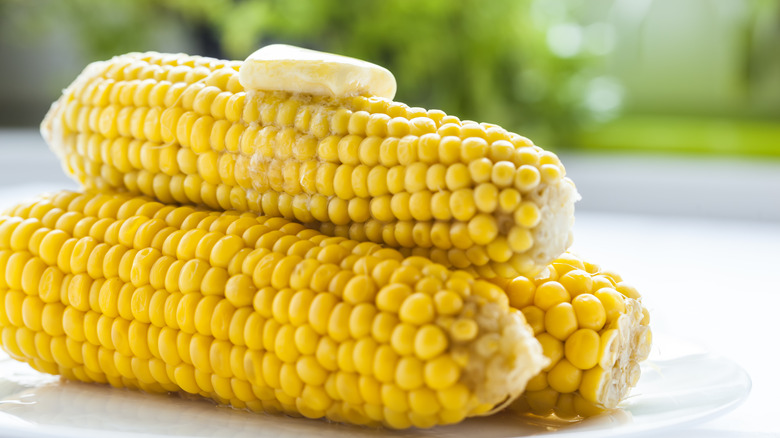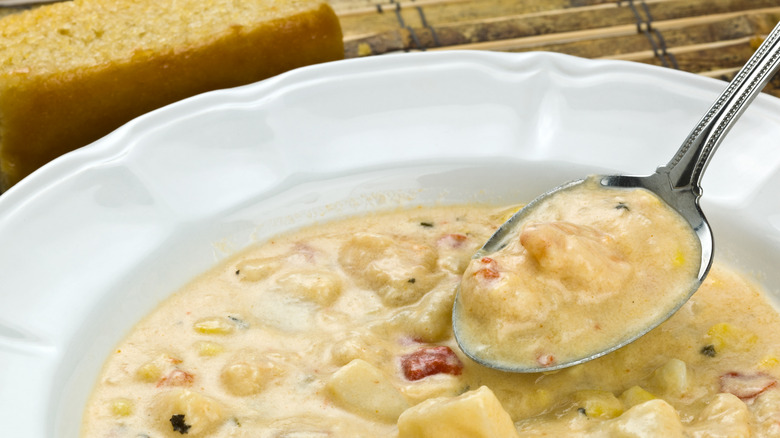14 Mistakes You Could Be Making With Corn On The Cob
Imagine sinking your teeth into a juicy ear of corn. It's flavorful, naturally sweet, and provides some toothsome goodness. In fact, one large ear of corn has nearly three grams of dietary fiber and five grams of protein. According to Livestrong, it's got plenty of phytonutrients — including vitamin C, a host of B vitamins like folate, magnesium, zinc, copper, and eye-protective carotenoids. If you get it at its peak — fresh and in season — you'll hardly need to season it. Although, there are some delightful pairings that can make it truly scrumptious.
To get the best of its flavor and textural appeal, you should buy corn encased in its husk. Truly, it all starts with a quality ear of corn. But don't stop there. You've got to know how to prep it, store it, and cook it properly. If it is anything but plump, juicy, and sweet when you bite into it, you may be making some mistakes with your corn on the cob.
1. You buy it out of season
You may get sweet kernels from your grocer's frozen aisle year-round, as that corn is picked at its peak of ripeness. But it's not the same as biting into a fresh and juicy corn on the cob. And if you opt for a package of corn on the cob out-of-season, you won't reap the tasteful benefits of ripe, fresh-picked corn — silk threads, husk, and all. That's because as corn ages, the sugars convert to a blander starch, and, as Cook's Illustrated explains, the bitterness of its proteins increases as its sugar levels taper off. The fresher your corn is, the sweeter it will be.
Corn is especially delightful during dog days of summer; think bar-b-ques, potlucks, and dining outdoors. You'll undoubtedly get its optimal flavor when the heat is higher, the days are longer, and you're spending more time with company outdoors. You can enjoy a sweet corn on the cob anytime between May through September, as that's when it is in season.
2. You purchase it without the husk
Sure, it's convenient to buy corn without the seemingly messy silk and husk. But you'll be doing yourself and your tastebuds a disservice if you choose to buy your corn on the cob "bald." The husk not only protects the corn, but also keeps those kernels moist and flavorful. To shuck without the fuss, start by chopping off the stalk end (about 2 inches). Microwave the cob for a few minutes. Then, squeeze from the other end, shaking the corn out of the silk-lined husk. This will get all the silks off the kernels for your cleanest corn on the cob.
What to do if you've already peeled your husk off? Remove as much of the silk as you can, then wrap a large rubber band around your fingers and press along the kernels, moving down the length of the corn. Or, use a damp paper towel to do the same. And if you are environmentally conscious, you can reuse those husks to make tamales. Simply soak them in warm water for 10 minutes — this will keep them flexible and strong.
3. You pick a dry bunch
Though the husk protects its kernels, a good-looking package yields tastier corn. On the other hand, a sign of poor-tasting corn is when that husk starts to look dry or brittle. So, it's a good idea in this case to judge the book by its cover, so to say.
How will you get the best ears of corn? Start by looking at the husk. It should be bright green and hug the corn tightly. If you find some that are yellow and dry, that means your corn won't be as sweet. In the husk is the silk, but you'll only get a peek through its tassel that sticks out. This should be a slight brown or golden color. And it's best if it is a little sticky to the touch. That ensures there is moisture. And beyond looks and touch, the tassel should smell slightly sweet.
It may be tempting, but don't peel back the husk. That just allows air in, which dries out the corn. Instead, give the husk a good squeeze, working your way from the bottom to the top. The underlying corn kernels should feel firm and plump. There shouldn't be soft spots or voids.
4. You don't store it properly
Imagine picking your corn fresh from the farm, unpeeling that green husk and silky threads, and slicing off some golden sweet kernels. Your corn will be fresh, sweet, and at its best flavor. In fact, once picked, the kernels' sugars begin converting to starch, reducing the sweetness over time. Hence, the sooner you get to eat it, the better it will taste.
But for those of us who don't live on a farm, we must settle for second best — getting your corn in husk from your grocer or local farmers' market. That said, it is best to eat your corn the same day you buy it. You can even leave it in the husk on your countertop the same day until you are ready to prep it for your meal. That husk will prevent the corn from drying out. If you need to wait a day or two, you can store it — ideally with the husk intact — in an airtight bag in the refrigerator. The cooler temperature will slow the conversion of sugar to starch, keeping your corn fresh, sweet, and tasty.
5. You haven't tried it raw
Corn is delicious raw. Just be sure to shuck it well and rinse off any dirt or debris. You can even bite right into your corn on the cob. Or, add a bit of salt and/or brush on some olive oil. Although at this fresh stage, the corn is still very sweet, so you'll probably need nothing at all.
There are so many ways to enjoy your corn raw. For one, you can enjoy it in a salad. The plump, juicy kernels will add a nice pop. Slice down the length of your corn to get a band of kernels. Continue around the cob until all the kernels are gone. Then, break up ribbons of kernels to distribute over your greens. You can also enjoy fresh, sliced kernels over bruschetta – the golden, olive oil-brushed toast that carries a delicious blend of tomato and herbs. Or serve it on avocado toast. However you enjoy it, remember the sooner you eat it, the better it will taste.
6. You boil your corn
To be fair, boiling your corn is not a horrible thing. In fact, you can still enjoy a good taste so long as you don't overcook it. However, boiling does impart some nutrient losses. The good news is that you still get plenty of dietary fiber (2.86 grams), and a bit of good ole plant protein from one large ear of corn. You just won't get the full extent of corn's nutritional potential. That's because some of its nutrients leach into the water as it is cooking. Thus, you'll be getting less folate and other water-soluble vitamins, as explained by All Recipes.
Not all is lost, however. You can always combine your corn with folate-rich broccoli or leafy greens, tomatoes, and beans to get in more of those lost nutrients. Or, consider using it in these corn, broccoli, and cheddar muffins. But, if you want to get the most out of your corn's nutrient density, you may want to consider broiling, grilling, or steaming it instead.
7. You overcook it
No matter how you choose to cook it, you'll get a more flavorful ear of corn if you don't overcook it. Over-boiling will yield a soggy ear of corn because the water penetrates into its starchy kernels, dissolving its pectins, which makes it mushy. So follow these guidelines. For corn with its husk, it can be a safe bet to boil it for just 10 minutes. You may find that the husk is easier to remove once the corn has been cooked. Without the husk, it may only require five minutes, most. And for those who prefer the convenience of frozen corn, it will be close to five to eight minutes.
Other methods of cooking corn also require attention to get the best of its juicy kernels. If grilling, be sure to rotate your ear(s) often, so it cooks evenly. Slow is the way to go, but don't leave it on the grill for more than 20 minutes because that can render a mushy result. You'll know it's done by pressing a kernel — it should release some liquid.
8. You are cooling it under water
One of the pleasing aspects of corn is that hearty, somewhat al dente texture. Sure, you want it juicy, but not watered down. In fact, you'll be making a mistake if you cool it under water. Just like over-boiling, that rush of water can make your corn soggy. You'll be better off letting it sit to cool — off the stove, drained, and onto a cooler countertop. That extra few minutes will be worth the pleasant pop of those juicy, sweet kernels.
Interestingly, though, if you should choose to freeze any extra corn, an ice bath might seal in its flavor and toothy texture. That's because it immediately halts the cooking process — it's a method known as blanching. Once cooked, use tongs to remove it from boiling water directly into a bowl of ice-cold water. Let it soak no longer than 5 minutes since it only takes that long to cook your corn. Then, remove it and pat it dry. You'll then wrap it and place it in the freezer. It should be frozen within 2 hours.
9. You don't steam it correctly
Steaming corn may not require much more time than boiling. And there are a few different ways you can achieve a tasty, steamed ear of corn. One method of steaming requires but four items: A pot, a steaming basket, water, and your corn. Start by filling your pot with water — but don't let that water line touch the steamer basket. Place the corn in the steamer basket and add that to the top of your water-filled pot. Then set your heat to high and cover until you see steam. Continue to cook for about five minutes more. Another method is to boil your water first, then add the corn to the steamer basket. Sealing the lid tightly once added will seal in the flavor and keep it juicy and tender.
Chef Brendan Walsh explained to Today that you should steam it in its husk to seal in its flavor. "You're keeping it encased right inside the husk, so when you peel it, the aroma and flavor is that much stronger," Walsh told Today. For this reason, he also recommends using the whole husk in all methods of cooking corn. Fill a tall stockpot with one-and-a-half to two inches of water and stand the corn up lengthwise in the steamer, stock side down. Then, bring the water to a boil, cover, and cook for another 15 to 20 minutes.
10. You haven't tried grilling it
If you don't grill your corn, you may be missing some flaming good flavor. Because corn is comprised mainly of starch, it will caramelize over high heat, bringing out a richer, sweeter, and slightly nutty flavor. It also gives it smoky essence, something we desire in a bar-b-que dish. And you just might find those grill marks appealing. It may be easier to grill than you think.
If you already have a grill set up for your meat or veggie kebabs, why not just add your corn? You can place your corn on the cob directly onto the flaming grill and cook until the side on the grill starts to brown. Then, rotate it around until each side is evenly golden. If you choose to cook it in its husk, soak it for 10 minutes first. The steam that fills the husk will cook the kernels more evenly. Finally, season it as you like — spicy, sweet-and-tangy, or with your favorite blend of savory herbs.
11. You don't season it without butter and salt
Salt adds to your corn's sweetness and the creaminess of butter keeps it delightfully rich. But if that's your only go-to, you might be missing out on some other great tasty corn pairings. So, introduce your tastebuds to some delicious new flavoring options.
To create a Mexican street-style corn, you can brush it up with olive oil, toss on some Cotija cheese, sprinkle on chili powder, and add a fresh squeeze of lime. And, if you still love the richness of butter, you can add some lemon juice and fresh lime in place of the salt. A delicious curry spread for your corn on the cob might include curry paste, some mayo, and coconut milk — topped with diced tomatoes and chopped green onions. You can even just spread a tablespoon of your pesto onto your fresh, hot ear of corn. Or, slather it with bar-b-que sauce.
But for those looking to cut back on sodium and cholesterol, there are other ways to make it tasty. A cilantro-lime spread can be made by mixing olive oil with fresh chopped cilantro, minced garlic, and zest of lime. Or, you can simply spray it with olive oil and top it with your favorite seasoning blend, such as furikake, zaatar, or everything bagel seasoning. You can even opt for fresh chopped fresh basil or whatever fresh herbs you may have available.
12. You don't consider pairing it with fruit
Corn with other veggies may seem a commonplace thing. You may have had it with peas, broccoli, carrots, potatoes, and even in those leafy green salads or grain bowls. But pairing corn with fruit may seem foreign. Although, if you eat tomatoes or avocado (both technically fruits), you've likely had this type of combo before.
Consider a watermelon salad, enhanced with juicy corn kernels direct from your freshly grilled cob. Or swap out your tortilla chips for ribbons of corn you slice vertically from your cob. Hint: It makes a great base to slather up some tasty guacamole. Even better, you can forgo the sliced baguette and use those ribbons of corn for a delicious tomato-corn bruschetta. When you add fresh kernels of corn to your watermelon salad, it can make it even more satisfying. It also adds a pop of color and texture to your watermelon, feta, and basil medley. And when you serve it up with tomatoes — in equal bite-sized pieces — you get a refreshing, somewhat tangy, and juicy combination.
13. You don't know how to reheat it
You've cooked your corn to a sweet, juicy perfection. But you may worry that reheating your leftover corn will make it tough, watery, or unpalatable. Fear not. You can still enjoy leftover corn on the cob by using a variety of means to reheat.
Some great appliances for reheating include an air fryer (or convection oven), a grill, or for even more convenience, your microwave. If you are using an air fryer, just add your corn to the basket or tray, lock it into place (or close the lid) and set it up to air fry. It will take about three to four minutes at 350 degrees Fahrenheit to fully reheat. To reheat your corn on the grill, you'll need to brush butter or oil onto your corn cobs, place them on the grill, and rotate everything for 30 seconds until each side has been heated twice. If you plan to use a microwave, you'll need a microwave-safe dish and a damp paper towel. Place the corn in the dish, add a few tablespoons of water, seal the lid on securely, then microwave for 30 seconds. Then flip the corn and reheat for 30 seconds. If it is not heated through, continue microwaving for an additional 30 seconds.
14. You are not creative with your leftovers
So, you've got more corn ears than you and your family can eat. How are you going to repurpose those leftovers? Sure, you can enjoy that same ear of corn (reheated) the very next day. But don't forget, those corn kernels work perfectly in soups and stews. And they're a delicious, fresh add-in for your salads. You can use them to make corn fritters or even a delightful creamy corn soup. And if you've got a box of cornbread mix, why not add them to the mix for a good ole pop of corn in every bite?
Some other great ways to repurpose leftover corn include adding them into a veggie burger mix, cooking them into your omelets, or mixing those kernels into a fresh salsa. You can sprinkle corn into your grits, use it to replace some of the rice in your risotto, or even enjoy them in mashed potatoes. Because they're starchy and mildly sweet, they can be quite versatile.
